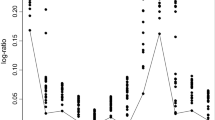Abstract
Data Envelopment Analysis is used for evaluating the technical efficiency of museum institutions. This approach enables us to create for each museum a relative efficiency measure, which takes into account both the resources used by museums and the results of their activities. Moreover this technique is able to overcome some of the difficulties found when applying more traditional indicators of productivity in evaluating the technical efficiency of cultural institutions. An empirical analysis carried out on data from Italian municipal museums illustrates this application of the operational research model.
Similar content being viewed by others
References
Ames, P.J. (1994) “Measuring Museum's Merits”, in K. Moore (ed.), Museum Management. Routledge, London, New York.
Banker, R.D., Charnes, A., and Cooper, W.W. (1984) “Some Models for Estimating Technical and Scale Inefficiencies in Data Envelopment Analysis”. Management Science 30: 1078–1092.
Banker, R.D. and Morey, R.C. (1986) “The Use of Categorical Variables in Data Envelopment Analysis”. Management Science 32: 1613–1627.
Boussofiane, A., Dyson, R.G., and Thanassoulis, E. (1991) “Applied Data Envelopment Analysis”. European Journal of Operational Research 52: 1–15.
Carlini, L. (1996) “Firenze: arte ed economia”, in A. Roncaccioli (ed.), L'azienda museo, problemi economici, gestionali, organizzaztivi. Cedam.
Charnes, A. and Cooper, W.W. (1962) “Programming with Linear Fractional Functionals”. Naval Research Logistics Quarterly 9: 181–185.
Charnes, A., Cooper, W.W., and Rhodes, E. (1978a) “A Data Envelopment Analysis Approach to Evaluation of the Program Follow through Experiments in U.S. Public School Education”. Management Science Research Report no. 432. Carnegie-Mellon University, School of Urban and Public Affairs, Pittsburgh, PA.
Charnes, A., Cooper, W.W., and Rhodes, E. (1978b) “Measuring the Efficiency of Decision-Making Units”. European Journal of Operational Research 2: 429–444.
Charnes, A., Cooper, W.W., Lewin, A.Y., and Seiford, L.M. (1994) Data Envelopment Analysis: Theory, Methodology and Application. Kluwer Academic Publishers, Dordrecht.
Cooper,W.W., Seiford, L.M., and Tone, K. (2000) Data Envelopment Analysis, a Comprehensive Text with Models, Applications, References and DEA-Solver Software. Kluwer Academic Publishers, Dordrecht.
Doyle, J. and Green, R. (1994) “Efficiency and Cross-Efficiency in DEA: Derivations, Meanings and Uses”. Journal of the Operational Research Society 45: 567–578.
Farrell, M.J. (1957) “The Measurement of Productive Efficiency”. Journal of the Royal Statistical Society 120: 253–281.
Forsund, F.R. and Sarafoglou, N. (2002) “On the Origins of Data Envelopment Analysis”. Journal of Productivity Analysis 17: 23–40.
Funari, S. and Simionato, I. (1996) “I musei veneziani: indagine sulle strutture permanenti”, in A. Roncaccioli (a cura di), L'azienda museo, problemi economici, gestionali, organizzaztivi. Cedam.
Greenberg, R. and Nunamaker, T. (1987) “A Generalized Multiple Criteria Model for Control and Evaluation of Nonprofit Organizations”. Financial Accountability and Management 3: 331–342.
Jackson, R. (1988) “A Museum Cost Function”. Journal of Cultural Economics 12: 41–50.
Jackson, P.M. (1994) “Performance Indicators: Promises and Pitfalls”, in K. Moore (ed.), Museum Management. Routledge, London, New York.
Luenberger, D.G. (1984) Linear and Nonlinear Programming. Addison-Wesley Publishing, Reading, MA.
Luksetich, W. and Nold Hughes, P. (1997) “Efficiency of Fund-Raising Activities: An Application of Data Envelopment Analysis”. Nonprofit and Voluntary Sector Quarterly 26: 73–84.
Mairesse, F. and Vanden Eeckaut, P. (2002) “Museum Assessment and FDH Technology: Towards a Global Approach”. Journal of Cultural Economics 26: 261–286.
Pignataro, G. and Zangola, R. (2001) “Analisi dell'efficienza dei musei”, in P.A. Valentino and G. Mossetto (eds.), Museo contro museo: Le strategie, gli strumenti, i risultati. Giunti, Florence.
Primicerio, D. (1991) L'Italia dei Musei-Indagine su un patrimonio sommerso. Electa.
Ray, S.C. (2002) “William W. Cooper: A Legend in His Own Times”. Journal of Productivity Analysis 17: 7–12.
Seiford, L.M. (1994) “A DEA Bibliography (1978–1992)”, in A. Charnes, W.W. Cooper, A.Y. Lewin, and L.M. Seiford, Data Envelopment Analysis: Theory, Methodology and Application. Kluwer Academic Publishers, Dordrecht.
Zaleski, P.A. and Zech, C.E. (1997) “Efficiency in Religious Organization”. Nonprofit Management and Leadership 8: 3–18.
Zan, L. (2000) “Managerialisation Processes and Performance in Arts Organizations: The Archaeological Museum of Bologna”. Scandinavian Journal of Management 16: 431–454.
Author information
Authors and Affiliations
Rights and permissions
About this article
Cite this article
Basso, A., Funari, S. A Quantitative Approach to Evaluate the Relative Efficiency of Museums. Journal of Cultural Economics 28, 195–216 (2004). https://doi.org/10.1023/B:JCEC.0000037997.23746.f2
Issue Date:
DOI: https://doi.org/10.1023/B:JCEC.0000037997.23746.f2




